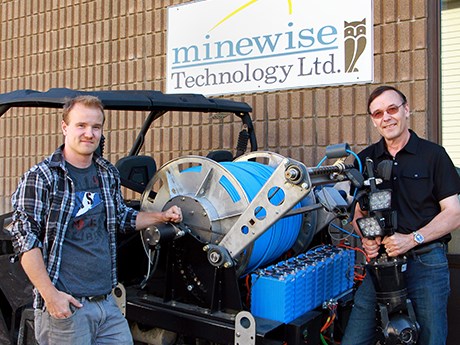A major mining company had a unique challenge and came knocking on the door of Sudbury-based Minewise Technology Ltd.
The challenge involved an inspection of a sealed-off abandoned shaft to assist with a feasibility study on a possible mine development project.
This wasn’t a job for a human being. A mounted camera unit was required because the company wanted to see everything in the shaft, from top to bottom, regardless of hazards.
“People bring us a niche problem and ask us to solve it,” Minewise technical manager Everett Henderson said. “We have a reputation for working with cameras in oddball ways. We innovate and come up with solutions. We are adaptable to niche problems. It is the model our business works around.”
The challenge came to Minewise through word-of-mouth and the company’s already good standing in the Sudbury mining camp. Minewise staff had worked on smaller projects with the mining company, and it led to this unique test of mettle.
Minewise had a custom fibre optic cable constructed with a tension member in the middle wrapped up with multiple fibre optic conductors and power conductors. They then custom-built a long reach inspection reel “from scratch.” It is a self-contained unit that runs off lithium batteries and is made of heavy-duty steel.
The unit fits onto the back of a slightly modified Polaris Ranger side-by-side 4X4 vehicle. The only modification was the removal of the back hauling bed, which was replaced by the reel unit. The cable was also designed not to twist, eliminating a key issue for many cameras dropped down holes attached to video cables.
The unit has precise speed and torque control, so operators can maneuver it up and down by the smallest increments. The cable is attached to a digital camera capable of panning 360-degrees and fitted with several powerful spotlights. The camera features a 30X zoom lens and is equipped with a windshield wiper to keep the protective lens free of water and debris. The vehicle backs up to an inspection hole at a mine and a big pulley is set up over top of it. The camera is then lowered down the hole.
The operators sit back and watch the show unfold from a laptop on the surface beside the vehicle. It is more or less like a “giant fishing reel.”
“It is capable of doing a 4,500 feet of inspections in a single pass,” Minewise product specialist James Henderson said. “It shows what kind of stuff we can do right here in our own backyard.”
The inspection involved sending the camera 3,800 feet down the shaft. Video was recorded as the camera dropped at an average rate of 30 feet per minute. The customer was looking for any anomalies and the condition of the concrete and electric cables, as well as water inflows, shaft stations at every 1,000 feet, ground supports, water pipes, vent ducts and the overall general health of the shaft.
At the 3,800-foot level, the camera encountered water. The remaining 1,000 feet of shaft was under water. Minewise brought the camera up and sent down another one designed to be submersible and disposable. It was able to penetrate 400 feet into the murky water until pressure crushed the camera.
“It was interesting,” said Everett Henderson. “To go in and confirm what the company has going on down there has a big bearing on their feasibility study. They now have a good idea of what they have to do and not do in that shaft.”
The camera can also be fitted with numerous sensors to enhance its capabilities. Gas levels, temperature levels and distance profile sensors can be attached and coupled up with video. There is also a digital link via separate conductors in the wire to detonate a blast. A grapple can also be attached so the unit can pick up items from the bottom of holes. It can record audio, and provide up to 500 watts of power in a hole.
Minewise staff invested a lot of time into learning what boundaries they could push with fibre optic cables.
“We did it this way so we could always do more,” James Henderson said. “It’s set up for a lot of weird stuff. The cable could be lowered down to provide wireless connection. You can do whatever you want. It lets you tackle a wide range of problems rather than just being a camera in a hole taking video. It was built to be flexible.”



